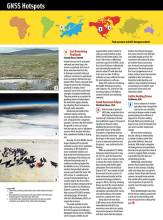 One of 12 magnetograms recorded at Greenwich Observatory during the Great Geomagnetic Storm of 1859
One of 12 magnetograms recorded at Greenwich Observatory during the Great Geomagnetic Storm of 1859 1996 soccer game in the Midwest, (Rick Dikeman image)
1996 soccer game in the Midwest, (Rick Dikeman image)
 Nouméa ground station after the flood
Nouméa ground station after the flood A pencil and a coffee cup show the size of NASA’s teeny tiny PhoneSat
A pencil and a coffee cup show the size of NASA’s teeny tiny PhoneSat Bonus Hotspot: Naro Tartaruga AUV
Bonus Hotspot: Naro Tartaruga AUV
 Pacific lamprey spawning (photo by Jeremy Monroe, Fresh Waters Illustrated)
Pacific lamprey spawning (photo by Jeremy Monroe, Fresh Waters Illustrated) “Return of the Bucentaurn to the Molo on Ascension Day”, by (Giovanni Antonio Canal) Canaletto
“Return of the Bucentaurn to the Molo on Ascension Day”, by (Giovanni Antonio Canal) Canaletto The U.S. Naval Observatory Alternate Master Clock at 2nd Space Operations Squadron, Schriever AFB in Colorado. This photo was taken in January, 2006 during the addition of a leap second. The USNO master clocks control GPS timing. They are accurate to within one second every 20 million years (Satellites are so picky! Humans, on the other hand, just want to know if we’re too late for lunch) USAF photo by A1C Jason Ridder.
The U.S. Naval Observatory Alternate Master Clock at 2nd Space Operations Squadron, Schriever AFB in Colorado. This photo was taken in January, 2006 during the addition of a leap second. The USNO master clocks control GPS timing. They are accurate to within one second every 20 million years (Satellites are so picky! Humans, on the other hand, just want to know if we’re too late for lunch) USAF photo by A1C Jason Ridder.  Detail of Compass/ BeiDou2 system diagram
Detail of Compass/ BeiDou2 system diagram Hotspot 6: Beluga A300 600ST
Hotspot 6: Beluga A300 600ST

1. GET GPS ON THE MOBILE!
Chicago GPS market study
√ The vast majority of Americans don’t have GPS on their cell phones – but 24% say they want it on their next one. This puts GPS ahead of Internet access, which only 19% prefer. Nearly 1/3 of Americans – including the middle-aged and elderly —have used a GPS-enabled device. So says Leo J. Shapiro LLC, a Chicago-based market research firm, which conducted national surveys last October and December.
1. GET GPS ON THE MOBILE!
Chicago GPS market study
√ The vast majority of Americans don’t have GPS on their cell phones – but 24% say they want it on their next one. This puts GPS ahead of Internet access, which only 19% prefer. Nearly 1/3 of Americans – including the middle-aged and elderly —have used a GPS-enabled device. So says Leo J. Shapiro LLC, a Chicago-based market research firm, which conducted national surveys last October and December.
2. NEW AND IMPROVED
Cape Canaveral Air Force Station
√ GPS IIR-M went up last December 20 at Cape Canaveral Air Force Station, Florida, aboard a United Launch Alliance Delta II rocket. U.S. Air Force controllers set the spacecraft to “healthy” status on January 2, in what is a record time of 13 days. It’s the fifth modernized replenishment satellite to launch.
3. COMPANY FOR GIOVE-A?
ESTEC, Noordvijk, The Netherlands
√ GIOVE-B, the Galileo program’s larger second experimental satellite, is all dressed up with one hydrogen maser and two rubidium clocks and may be ready to go. It is scheduled to be put into orbit on April 14. Starsem, the company in charge of launching Soyuz rockets, will do the honors.
4. GLONASS ON SCHEDULE
Baikonur Cosmodrome, Kazakhstan
√ Launch of three satellites on December 25, 2007, kept the Russian GNSS system on schedule to restore and modernize the second-oldest GNSS constellation.
5. 2008’S FIRST SUNSPOT
2008’s First Sunspot, January 6
√ NOAA scientists said a new 11-year cycle of heightened solar activity is on its way: the cycle’s first sunspot appeared in the sun’s northern hemisphere on January 6. GNSSes will feel the punch – including signal errors for a few days during each solar storm. (Read the November/December 2007 Inside GNSS article about Solar Weather)
6. HUNTING THE HUNTERS
Southern Ocean confrontation
√ Two whale defender groups – at loggerheads with each other over tactics – are trying to intercept Japan’s whaling fleet in the Southern Ocean, using GPS to find the ships in an area larger than the U.S. landmass. (Japan, Iceland, and Norway are the only countries that ignore a 1986 international treaty to protect humpbacks and other endangered whales.) Greenpeace and Sea Shepherd ships are now in the Antarctic.



